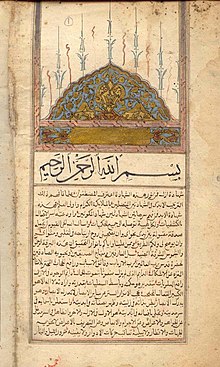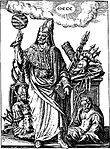Ahmad al-Buni

| Part of a series on |
| Hermeticism |
|---|
 |
Ahmad ibn ‘Ali al-Buni (Arabic: أحمد البوني), also called Sharaf al-Din or Shihab al-Din Ahmad ibn Ali ibn Yusuf al-Buni al-Maliki al-ifriqi (born in Annaba, Algeria died 1225) was an Algerian[1] mathematician and philosopher and a well known Sufi and writer on the esoteric value of letters and topics relating to mathematics, sihr (sorcery) and spirituality, but very little is known about him. Al-Buni lived in Egypt and learned from many eminent Sufi masters of his time.[2]
A contemporary of Ibn Arabi,[3] he is best known for writing one of the most important books of his era; the Shams al-Ma'arif, a book that is still regarded as the foremost occult text on talismans and divination. It was to be banned soon after as heretical.
Contributions

Theurgy
Instead of sihr (Sorcery), this kind of magic was called Ilm al-Hikmah (Knowledge of the Wisdom), Ilm al-simiyah (Study of the Divine Names) and Ruhaniyat (Spirituality). Most of the so-called mujarrabât ("time-tested methods") books on sorcery in the Muslim world are simplified excerpts from the Shams al-ma`ârif.[4] The book remains the seminal work on Theurgy and esoteric arts to this day.
Mathematics and science
In c. 1200, Ahmad al-Buni showed how to construct magic squares using a simple bordering technique, but he may not have discovered the method himself. Al-Buni wrote about Latin squares and constructed, for example, 4 x 4 Latin squares using letters from one of the 99 names of Allah. His works on traditional healing remains a point of reference among Yoruba Muslim healers in Nigeria and other areas of the Muslim world.[5]
His influence
His work is said to have influenced the Hurufis and the New Lettrist International.[6]
Denis MacEoin in a 1985 article in Studia Iranica said that Al-Buni may also have indirectly influenced the late Shi'i movement of Babism. MacEoin said that Babis made widespread use of talismans and magical letters.[7]
Writings
- Shams al-Maʿārif al-Kubrā[8] (The Great Sun of Gnoses), Cairo, 1928.
- Sharḥ Ism Allāh al-aʿẓam fī al-rūḥānī, printed in 1357 AH or in Egypt al-Maṭbaʿa al-Maḥmudiyya al-Tujjariyya bi'l-Azhar.
- Kabs al-iktidā, Oriental Manuscripts in Durham University Library.
- Berhatiah, Ancient Magick Conjuration Of Power.
References
- ^ B. G. Martin, Muslim Brotherhoods in Nineteenth-Century Africa, Cambridge University Press, 2003, p.149
- ^ By C. J. Bleeker, G. Widengren, Historia Religionum, Volume 2 Religions of the Present, p.156,
- ^ Vincent J. Cornell, Realm of the Saint: Power and Authority in Moroccan Sufism, University of Texas Press, 1998, p. 221
- ^ Martin van Bruinessen, "Global and local in Indonesian Islam", Southeast Asian Studies (Kyoto) vol. 37, no.2 (1999), 46-63
- ^ Diagnosis through rosary and sand: Islamic elements in the healing custom of the Yoruba (Nigeria). Sanni A. Lagos State University, Nigeria
- ^ Shams al-Ma'arif al-Kubra ۞ The Sun of Great Knowledge.
- ^ Denis MacEoin, ‘Nineteenth-Century Babi Talismans’, Studia Iranica 14:1 (1985), pp.77-98.]
- ^ https://quranwahadith.com/product/shams-ul-maarif-ul-kubra-urdu/
Notes
- Edgar W. Francis, Mapping the Boundaries between Magic. The Names of God in the Writings of Ahmad ibn Ali al-Buni
External links
- Articles needing cleanup from March 2010
- Cleanup tagged articles without a reason field from March 2010
- Wikipedia pages needing cleanup from March 2010
- 1225 deaths
- 13th-century Arabs
- Algerian Sufis
- Magic squares
- Mathematicians of medieval Islam
- Medieval Egyptian mathematicians
- Medieval Arab mathematicians
- Muslim occultists
- Sufi writers
- People from Annaba
- 13th-century Moorish people
- Algerian emigrants to Egypt
- People from the Almohad Caliphate
